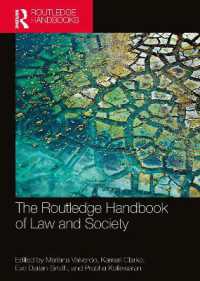- ホーム
- > 洋書
- > 英文書
- > Politics / International Relations
Full Description
In this precisely argued book, Colin Crouch questions the current meaning of political parties for citizens in Western Europe given that the identities on which they are based were the product of past conflicts over industrialization and religion. Crouch asks whether the issues confronting post and ex-industrial societies can develop their own political identities among citizens? And, if so, how far do these identities relate to the inheritance of the past?
Applying a theory of political identity, Crouch analyses voting behaviour across Europe and presents an in-depth historical analysis of the key political parties. He traces the content of party manifestos and the geographical and industrial status of parties' support. He argues that, far from following a model provided by the West, the faltering party systems in Central and Eastern Europe offer insights as to how western systems may develop in the future. Looking ahead, Crouch considers the viability of democratic politics, assessing the roles of gender, environmentalism and xenophobia in generating effective modern political identities.
Rethinking Political Identity is an invaluable resource for academics and researchers specialising in comparative European politics, political science, sociology and social policy, human geography and social history. It will also be of value to public policymakers and think tank professionals across Europe.
Contents
Contents
PART I EXCLUSION AND INCLUSION IN THE
FORMATION OF POLITICAL IDENTITIES
1 Political parties and social identities 3
2 Frameworks of analysis 27
3 European political parties since 1945 37
PART II PARTIES: THEIR POLITICAL STANCES AND
THEIR GEOGRAPHICAL BASES, 1945-2024
4 Consolidation of post-war western party systems: c. 1945 to
c. 1970 101
5 The age of (limited) dealignment: 1970s to c. 1989 133
6 From the collapse of the Soviet bloc to the eve of the
financial crisis (1990 to 2007) 177
7 From 2008 to the early 2020s: Rationalism or nationalism? 247
PART III CONCLUSIONS
8 Where are we now? Political identities in the 2020s 287
References 307








